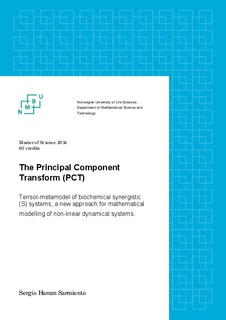| dc.description.abstract | In this thesis, a new approach, the principal component transform (PCT), is presented for mathematical modelling of synergistic biochemical systems (S-system) providing us with a simple and very accurate method for fitting these and other non-linear dynamical systems. The PCT is composed by two metamodels: one bi-linear metamodel and its improved version, a tensor-metamodel; both metamodels are based on the principal component analysis (PCA), which at the same time is based on the singular value decomposition (SVD). The tensor-metamodel is in addition based on mathematical attributes from tensor algebra, especially, the Kronecker product.
The PCT is inspired by the results of the PhD thesis of Julia Isaeva. She and her co-authors presented how many non-linear models can be approximated by a single bi-linear metamodel. Isaeva's publications have provided valuable knowledge which has been applied in the implementation of the PCT as a tool which deals with multivariate power functions.
Referring to the PCT, the loadings, which are orthogonal, span a subspace, where, after projecting a simple time-series (given by the S-system), we are able to find a function which behaves in the same way as the non-linear dynamical system described by the S-system. The process of projecting the time-series vector to the span of the loadings-vectors is carried out by the linear regression method.
This thesis did explore the possibility of using the scores, which belong to the PCT as a library, meaning that after having computed the linear regression, we ought to have been able to find the same parameters in this library. After having tested this hypothesis in the scalar case we could not find any logical correspondence between the parameters from the library and those parameters found by means of the linear regression method. These fundings are in accordance with the results presented by the PhD candidate Valeriya Tafintseva, where she confirms that the S-system formalism has a sloppy structure in the scalar case, meaning that they have a neutral parameter-set.
However, in higher dimensions, sloppiness seems to disappear, so that the data library can be constructed in an efficient way.
Regarding the bi-linear metamodel, it has been observed that the dimensionality of this method increases exponentially (n^3) and proportionally to the size of the S-system being studied. This leads, for big systems, to the formation of principal components belonging to a null subspace. This issue is solved in the tensor-metamodel, where the reduction of the dimensionality is given by the Kronecker product of the SVD.
Finally we can mention that the accuracy that each metamodel-phenome delivers is very good, meaning that more than 99% of the originally mathematical model is described by the PCT. | nb_NO |

